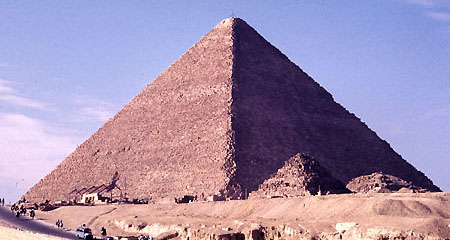HIS 101
Unit 1: Introduction

The Great Pyramid of Ancient Egypt; photo courtesy C. Wayne and Dorothy Miller.
 What you
must do in this unit
What you
must do in this unit
- Familiarize yourself with the textbook.
- For further course and contact information, read the introduction letter from your instructor
- Read the information on the course assignments and grading. This is very, very important.
- Read the course introduction notes.
- Since the use of proper grammar, spelling and style are an
inherent part of each assignment in this course, please check the course writing resources available in Charlie's History Writing Center for
more information.
- Study the Questions to Consider and the Key Terms for the unit. These are important for your midterm and final exams--you might want to take a look now at the exam information.
- Take the Course Introduction Check quiz. Log into Blackboard and you will see the button for the quiz in your course. This is a short, 10-question orientation quiz that you must take and pass with a score of 9/10 before you can continue in the course. If you must, you can re-take the quiz more than once. The quiz is also worth 10 points of extra credit.
- Submit the Required Introduction paragraph.
What you should do in this unit
What you
can do in this unit
- Listen to some further introductory remarks
as a mp3 file. You can also read the information as
a txt file.
- Watch the short clip of the Medieval Help Desk about some
problems that medieval monks faced with the transition from using
scrolls to reading books. Log into
Blackboard and check for it under course materials.
- Read some short remarks on Why Do We Teach and Study Western Civilization; or World Civilization, or Why Study Any History? We also have a list of history associations available.
- Review the sample analysis of an excerpt
from Hammurabi's code of laws. There will be many assignments in this course which will require
you to read and analyze a historical document.
- Begin to review for
the map portion of the midterm (unit 7) and final (unit 15) exams. Now is a good
time to begin to study and prepare. Please check the Blank
Western Civilization map and the Map items, a list of the geographical
places, features and areas that you will be expected to locate on a blank map for the tests. Check some recommended sources for map study.
- Years ago when the course was offered, we used television programs and then later audio lectures to supplement the reading in the course. Those videos and audio clips are now available on www.nvcc.edu/itunesu/ (under Open Courses look for HIS 101). That material does not exactly fit with some of the current assignments in the course, but you might find something interesting, useful or valuable there. In particular, check out the short clip on Death and Destruction in the Western World.
Extra Credit Options
- For 25 points of extra credit, review this
entire course website, check the online ELI student orientation and send your instructor any questions that you might have. This must be done in units 1 or 2 of the course to receive credit.
- For a maximum of 25 points of extra credit, comment in a long paragraph on the perspective of time displayed in Carl Sagan's Cosmic Calendar (also in slightly different versions at A Cosmic Calendar or The Cosmic Timeline). You can also watch this on YouTube. (well worth watching!) Here is a link to the actual timeline of the universe.
- Comment in a long paragraph on the remarks relevant to What is Civilization, and the characteristics of "civilization" according to François Pierre Guillaume Guizot, for a maximum of 25 points.
- You can also earn extra credit at any
time by (a)
finding a typo, spelling error or broken link (and sending me that information) or (b)
finding any website or web materials
that are relevant to this course. (Send the title of the site, the url and a
brief explanation why you find the information interesting and applicable to the course.)
- Other opportunities for extra credit?
- Suggest an assignment for use somewhere in the course. Be creative!
|



